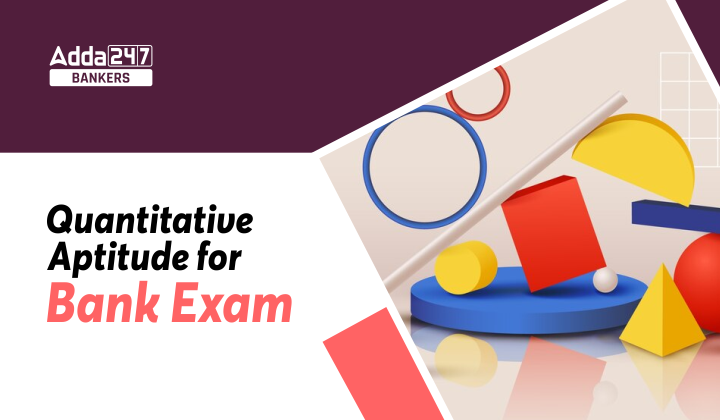
Quantitative Aptitude is a crucial section in most banking exams, as it tests a candidate’s numerical abilities and problem-solving skills. This section carries significant weight, and a strong performance can greatly improve your overall score and chance of getting selected. To excel in this section, it is essential to have a well-structured preparation strategy. In this article, we will guide you through the steps to effectively prepare for Quantitative Aptitude for upcoming bank exams.
What is Quantitative Aptitude For Bank exams?
Quantitative Aptitude is an integral portion involved in competitive bank exams. Quantitative Aptitude For Bank Exams enlightens around 30 to 50 questions in the Prelims stage and Mains phase. Moreover, the difficulty level of Quantitative Aptitude in the Mains round will be high as compared to the Prelims round. Students needs to grip up with the right analytical skills and problem-solving abilities to score in the following section. Here we have categorized the major sections involved in Quantitative Aptitude For Bank Exams.
- Data Interpretation and Analysis
- Quadratic Inequality
- Data Sufficiency
- Number Series
- Simplification or Approximation
- Arithmetic
Quantitative Aptitude Questions & Answers For Upcoming Bank Exams
Here are some questions that will help you prepare for the quantitative aptitude section which helps candidates to improve the score in the bank exams 2024.
Quantitative Aptitude Syllabus for Bank Exams
The Quantitative Aptitude Syllabus for Bank Exams includes the following topics:
01) Arithmetic: This includes basic mathematical operations such as addition, subtraction, multiplication, and division, along with topics like percentages, profit and loss, averages, ratios and proportions, time and distance, etc. Topics included in the Arithmetic are:
| Arithmetic | |
| Topic | Description |
| Percentage | Percentage questions in banking exams involve calculating percentage increases or decreases, finding the percentage of a given quantity, and solving problems related to profit and loss percentages. |
| Ratio & Proportion | Ratio and proportion questions assess candidates’ ability to compare quantities, find missing values in proportion, and solve problems involving the distribution of resources or the sharing of profits. (these 2 topics i.e. Percentage and Ratio & Proportion are extensively used in DI also) |
| Compound Interest and Simple Interest | These questions require candidates to calculate the interest accrued over time using compound and simple interest formulas, understand the difference between them, and solve problems related to investments and loans. |
| Profit and Loss | Profit and loss questions evaluate candidates’ understanding of selling price, cost price, profit and loss, and involve calculating profit percentage, and loss percentage, and determining the breakeven point. |
| Average | Average questions assess candidates’ ability to find the average of a set of numbers, solve problems involving weighted averages, and interpret averages in scenarios such as salaries, marks, or ages. |
| Problems on age | Age-related problems involve calculating the present age, finding the age difference between individuals, and solving problems related to the future or past ages of people. |
| Mixture and Allegation | Mixture and allegation questions involve finding the ratio of ingredients in a mixture, and determining the quantity of each ingredient when mixing two or more substances of different concentrations. |
| Time and Work | Time and work questions assess candidates ability to calculate the time taken to complete a task by individuals or groups working together or independently, considering their respective efficiencies. |
| Pipe and Cistern | Pipe and cistern problems require candidates to calculate the time taken to fill or empty a tank when pipes of different capacities are involved, considering inflow and outflow rates. |
| Speed, time and Distance | These questions involve calculating the speed of an object, the distance covered, or the time taken to travel a certain distance, considering variations in speed or time intervals. |
| Boat and Stream | Boat and stream problems assess candidates’ ability to calculate the speed of a boat or stream, determine the relative speed when moving upstream or downstream, and solve problems involving time and distance in river navigation. |
02) Data Interpretation (DI): DI involves interpreting data presented in various forms such as tables, graphs, charts, and histograms. Candidates must practice analyzing and solving questions based on this data efficiently. Data Interpretation questions in bank exams appear in various formats
| Data Interpretation | |
| Topics | Description |
| Bar Graph | Candidates are required to interpret the information presented in the bar graph and answer questions based on the data provided. |
| Line Graph | Candidates must analyse the trends depicted in the line graph and answer questions related to the trends, differences or comparisons. |
| Pie Chart | Candidates need to interpret the proportions or angles presented by each sector and answer questions related to percentages, fractions or comparisons |
| Tables | Candidates are required to analyze the data presented in the table and answer questions involving calculations, comparisons, or inferences. |
| Caselets | Candidates must read the caselet carefully, interpret the accompanying data, and answer questions based on the information provided in the caselet |
03) Number Series: Number series questions test one’s ability to identify patterns and relationships among numbers. Regular practice is essential to master this topic. The Number series questions appear in the exam in the following types
| Number Series | |
| Topic | Description |
| Missing Number Series | In this type of series, one or more numbers are missing, and candidates need to identify the pattern and determine the missing numbers from the available option. For example: 2, 5, _, 11, 14, 17 |
| Wrong Number Series |
In a wrong number series, one or more terms are incorrect, and candidates must identify the incorrect term and choose the correct term from the given options. For Example: 3, 8, 15, 25, 35, 48, 63
|
04) Simplification and Approximation: These questions assess candidates’ ability to simplify complex mathematical expressions and arrive at approximate values quickly.
05) Quadratic Equations: This topic involves solving quadratic equations and analyzing their roots. Proficiency in quadratic equations is crucial for scoring well in the Quantitative Aptitude section.
06) Mensuration: Mensuration questions involve the calculation of geometric shapes’ area, perimeter, volume, and surface area. These questions assess candidates’ ability to apply geometric formulas and concepts to solve problems related to banking scenarios such as calculating the area of land parcels or the volume of storage tanks.
07) Permutation & Combination: Permutation and combination questions assess candidates’ ability to count and arrange objects or events in various ways. Banking exam questions may involve determining the number of possible combinations for password creation, seating arrangements, or selecting committees from a group of individuals.
08) Probability: Probability questions evaluate candidates’ understanding of the likelihood of events occurring and involve calculating probabilities in different scenarios.
09) Inequality: Inequality questions assess candidates’ ability to compare quantities and determine their relationships using mathematical symbols such as greater than (>), less than (<), or equal to (=). Banking exam questions may involve solving inequality equations to determine loan eligibility criteria or assessing financial performance indicators.
10) Data Sufficiency: Data sufficiency questions assess candidates’ ability to determine whether the given data is sufficient to solve a problem. In banking exams, data sufficiency questions may involve analyzing financial statements, graphs, or tables to determine if the provided information is adequate to answer questions related to interest rates, loan approvals, or investment decisions.
Preparation Strategy for Quantitative Aptitude for Upcoming Bank Exams?
- Build Basic Concepts & Learn Formulas & Identities: Building basic concepts is the core element for scoring good marks in the Quantitative Aptitude section of any banking exam. It will help in solving easy to difficult questions. Sometimes conducting body asks questions directly on mathematical identities and formulas, so learn them thoroughly. It will help in solving easy to difficult questions.
- Develop Problem-Solving Skills: Merely understanding the concepts is not enough, candidates must develop problem-solving skills. Practising regularly is the key to developing this skill. Allocate a dedicated time each day for solving problems and gradually increase the difficulty level.
- Time Management: Time management plays a crucial role in banking exams. Learn to prioritize the questions based on their difficulty level and allocate time accordingly. During practice sessions, solve questions under timed conditions to improve speed and accuracy.
- Mental Calculation: It will save lots of time during the examination. Develop a habit of doing calculations in mind. For this, you must remember the Tables (till 30 at least), squares and cubes, etc. Try to do addition and subtraction without pen and paper.
- Revision and Mock Tests: Regularly revise to retain concepts and formulas. Create a revision schedule and revisit topics periodically to reinforce learning. Additionally, take regular mock tests to assess your preparation level and identify areas that need improvement. Analyze the mock test results thoroughly to understand your strengths and weaknesses and act accordingly.
- Stay Calm and Confident: Maintain a positive attitude and stay calm during the exam. Confidence in your preparation and abilities can significantly impact your performance. Remember to read questions carefully, manage time effectively, and avoid unnecessary stress.
Weightage Of Quantitative Aptitude For Bank Exams
An aspirant must understand the weightage of Quantitative Aptitude For Bank Exams. Before solving this section you need to categorize its weightage for a clarity review. Every banking exam is becoming extremely competitive due to the rising number of interested candidates. Moreover, the Quant section is becoming the primary concern for every student. So, for your understanding, we have given an approximate weightage of the Quant questions in every Prelims and Mains phase of the leading banking exams.
| Common Exams Quantitative Aptitude Weightage | ||||
| Exam Name | No. of Qs. of QA | Marks | QA section Weightage | |
| IBPS Clerk | Pre | 35 | 35 | 35% |
| Mains | 50 | 50 | 25% | |
| IBPS PO | Pre | 35 | 35 | 35% |
| Mains | 35 (DA & DI) | 60 | 30% | |
| SBI Clerk | Pre | 35 | 35 | 35% |
| Mains | 50 | 50 | 25% | |
| SBI PO | Pre | 35 | 35 | 35% |
| Mains | 30 (DA & DI) | 50 | 25% | |
| IBPS RRB Clerk | Pre | 40 | 40 | 50% |
| Mains | 40 | 50 | 25% | |
| IBPS RRB PO | Pre | 40 | 40 | 50% |
| Mains | 40 | 50 | 25% | |
Topic Wise Weightage of Quantitative Aptitude for Bank Exams for Prelims Exams
The Quantitative Aptitude Exam Analysis provides a comprehensive dissection of the number of questions appearing from various topics within the quantitative aptitude section of the exam. Understanding the distribution of questions aids in strategic planning, and candidates can allocate their preparation time wisely.
| Topic Wise Weightage of Quantitative Aptitude for Bank Exams for Prelims Exam | |||||||
| Topics | IBPS PO | IBPS Clerk | SBI PO | SBI Clerk | RRB PO | RRB Clerk | RBI Assistant |
| Number Series | 05 | 05 | 05 | 05 | 05 | 5 | 05 |
| Approximation & Simplification | – | 15 | – | 15 | 05 | 13 | 15 |
| Quadratic Equation | 05 | – | 05 | – | 04 | – | – |
| Caselet DI | – | – | 04 | – | 05 | – | – |
| Arithmetic | 13 | 10 | 10 | 10 | 11 | 12 | 10 |
| Data Interpretation | 12 | 5 | 11 | 05 | 10 | 10 | 05 |
| Total | 35 | 35 | 35 | 35 | 40 | 40 | 35 |
| Difficulty Level | Moderate | Easy | Moderate | Easy to Moderate | Moderate | Easy | Easy |
Topic Wise Weightage of Quantitative Aptitude for Mains Exam
| Topic Wise Weightage of Quantitative Aptitude for Mains Exam | |||||||
| Topics | IBPS PO (DA & DI only) | IBPS Clerk | SBI PO (DA & DI only) | SBI Clerk | RRB PO | RRB Clerk | RBI Assistant |
| Line Graph DI | 05 | – | 05 | 05 | – | 06 | – |
| Bar Graph DI | – | – | – | 03 | – | – | – |
| Tabular DI | 04 | 13 | – | – | 05 | 06 | 05 |
| Tabular DI- Percentage | 04 | – | – | – | – | – | – |
| Pie Chart DI | – | 06 | – | 07 | 05 | – | 05 |
| Arithmetic-Based DI | 03 | – | 12 | – | – | – | – |
| Caselet DI | – | 06 | 03 | 03 | 05 | 03 | 05 |
| Approximation | – | 05 | – | 04 | – | 05 | 05 |
| Quantity Comparison | 03 | – | – | 05 | 05 | – | 04 |
| Quadratic Equation | 01 | 03 | – | 04 | 04 | 02 | – |
| Number Series | 04 | 04 | 04 | 03 | 05 | 05 | 05 |
| Arithmetic | 05 | 13 | 06 | 16 | 11 | 10 | 11 |
| Algebra | 03 | – | – | – | – | – | – |
| Data Sufficiency | 03 | – | – | – | – | 03 | – |
| Total | 35 | 50 | 30 | 50 | 40 | 40 | 40 |
| Difficulty Level | Moderate to Difficult | Moderate to Difficult | Moderate to Difficult | Moderate to Difficult | Difficult | Easy to Moderate | Moderate |
Quantitative Aptitude Section With Tips & Tricks
Now you are well acquainted with the Quantitative Aptitude Syllabus and related topics. Here, we have delivered some expert and proven tips for the aspirants to score incredibly in the upcoming banking exams. Following these tips will make your Quantitative Aptitude preparation strategies more engrossing.
Understand Basic Formulas and Calculations
You need to start from the basics to reach that level of advanced calculations. Go for maximum numerical problems and practice them to elevate your calculation speed.
Be Precise With your Concepts
The Quantitative Aptitude section of any banking exam will be highly a skill-based test. So, you need to be extremely authentic with the basic formulas and concepts. Revise more and practice regularly to get acquainted with the numerical formulas and basic knowledge.
You Can Acquire Some Shortcut Techniques
Banking exams are all about your fluency and speed in solving problems. So, you can analyze the exam pattern and accordingly choose some shortcut techniques to solve the numerical problems more effectively. Through this, you can save a lot of time.
Practice More
Quantitative ability is one section that requires you to practice a lot because it has lots of formulas and you cannot learn them all until you have applied them to some questions. So make sure that you solve at least 30-40 questions related to one formula for a better understanding of it.
Quantitative Aptitude: Practice With Mock Test & Previous Year Papers
No matter which exam you are preparing for this is a one-stop solution for all your problems and can help you to score a very good score. Take a mock test with full efficiency and then analyze it properly. Analyzing the mock test is even more important than taking a mock test. There is no use if you are taking 5 mocks in a day but are not analyzing even a single properly because you are not learning from it and hence you are not improving.
Quantitative Aptitude Question And Answer
Average
Q1. If average of five consecutive odd numbers is 33, then the least odd number is:
(a) 27
(b) 31
(c) 29
(d) 23
(e) 33
Q2. The average weight of boys in a class of total strength 50 is 40 kg while the average weight of girls is 35 kg. Find number of girls in class if average weight of class is 38 kg.
(a) 10
(b) 30
(c) 20
(d) 40
(e) 15

Q3. Three year ago, the average age of five employee of a company was 54 yrs. The present average age is 52 yr after the inclusion of a new employee entered. Find the age of the new employee?
(a) 18 yr
(b) 25 yr
(c) 20 yr
(d) 22 yr
(e) 27 yr
Q4.Average of four numbers is increased by 1 when a number is replaced by x and average of that four number is decreased by 1 when another number is replaced with x. What is the difference of the both numbers?
(a) 6
(b) 8
(c) 16
(d) 4
(e) Cannot be determined

Ratio & Proportion
Q4. The ratio of milk and water in a vessel is 3: 10. If 10 liter of milk added in it, ratio of milk to water becomes 2 : 5. Find the initial quantity of mixture in the vessel. (in l)
(a) 78
(b) 130
(c) 169
(d) 104
(e) 148
Q5. In a vessel, 120 l mixture of alcohol and water is in the ratio of 5 : 3 respectively. Some water is added to the mixture & ratio of alcohol to water becomes 25 : 21. Find the added quantity of water (in l).
(a) 12
(b) 24
(c) 18
(d) 15
(e) 9
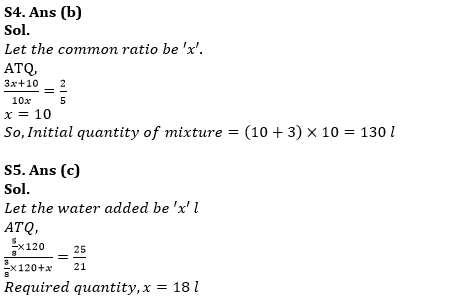
Q6. A vessel has mixture of milk and water containing 40% milk. If 18 liters more water added in vessel, then quantity of water becomes 75% of mixture. Find the initial quantity of milk in the vessel?
(a) 12 l
(b) 24 l
(c) 18 l
(d) 15 l
(e) 21 l
Q7. Two vessel A and B, which has mixtures of water and milk contains 25% and 50% water respectively. Find in what respective ratio should these mixtures be mixed so that the final mixture contains 60% milk.
(a) 1:1
(b) 5:4
(c) 4:5
(d) 3:2
(e) 2:3
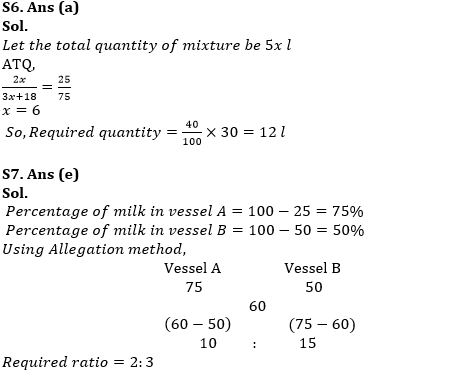
Time & Work
Q1. P and Q together can complete a work in 24 days, while Q and R working together can complete the same job in 32 days. P and Q start the work and did it for 8 days, after that P left the work and R joined Q and after 12 more days, Q also left the work. Then, the remaining work is completed by R in 28 days. Find in how many days R will complete the work alone?
(a) 96 days
(b) 72 days
(c) 108 days
(d) 90 days
(e) 81 days
Q2. ‘A’ is 40% less efficient than ‘B’ who can do the same work in 20% less time than ‘C’. If A and B together can complete 80% of work in 12 days, then in how many days 60% of work can be completed by B and C together.
(a) 2 days
(b) 4 days
(c) 6 days
(d) 8 days
(e) 10 days
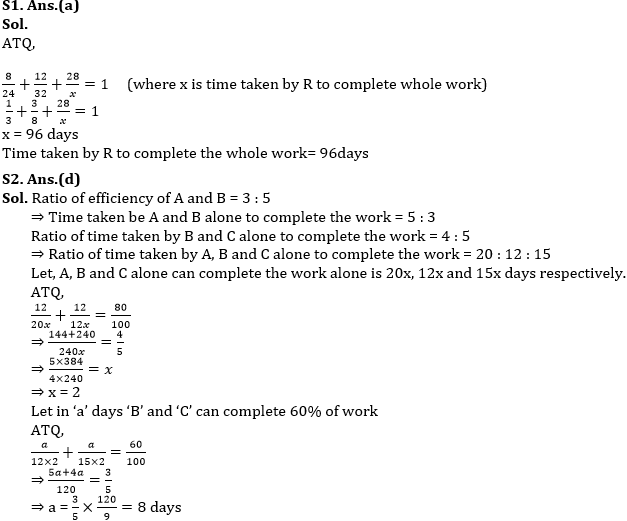
Candidates can also check a set of mix questions from different topics given below
Directions (1-5): study the given information carefully and answer the questions.
In a company, there are 3 companies laptop provided to its employee i.e. Dell, HP & Lenevo There are total 1000 employees. Some employees use single laptop while some uses more than it. 20 users uses all 3 companies laptop. 150 employees use more than one company’s laptop. 200 employees use only Lenovo’s laptop while 280 use only HP’s laptop. 40% of total employees use HP’s laptop & same no. of employees uses HP & Dell both & HP & Lenovo both.
Q1. How many employees are using both Dell & Lenovo together?
(a) 20
(b) 30
(c) 50
(d) 40
(e) 10
Q2. Employees using only Dell’s laptop are what percent of employees using only Lenovo’s laptop?
(a) 140%
(b) 150%
(c) 175%
(d) 165%
(e) None of these
Q3. What is the ratio of employees using both Dell & Lenovo laptops together to employees using all 3 companies laptops?
(a) 3:2
(b) 2:3
(c) 3:5
(d) 5:3
(e) 5:2
Q4. Employees using Dell are what percent more than employees using Lenovo?
(a) 40%
(b) 85%
(c) 33.33%
(d) 12.5%
(e) 56.67%
Q5. How many employees uses only one company’s laptop?
(a) 860
(b) 870
(c) 850
(d) 830
(e) 840

Q7. Akshay buys an article and markup it 30 % above its cost price. At the time of sale, he gives 10% discount instead of 15% due to which he earns Rs. 13 more. Find cost price.
(a) Rs. 230
(b) None of these
(c) Rs. 150
(d) Rs. 130
(e) Rs. 200
Q8. Sanjay starts from his home to reach office at uniform speed of 5 kmph. After 20 minutes, Anurag starts cycling at uniform speed of 12 kmph in same direction from same point. At what distance, he will catch Sanjay? (approx)
(a) 7 km
(b) 4 km
(c) 5 km
(d) 2 km
(e) 3 km
Q9. A sum of Rs. P was invested at 10% for 2 years at simple interest. If the same sum was invested at 20% for ‘x’ years, it would have fetched Rs. 200 more. Find ‘x’ if Px = 5000. (value of x is given in months)
(a) 12
(b) 18
(c) 15
(d) Cannot be determined
(e) None of these
Q10. 4 men & 3 children completes a project for Rs. 600 in 3 days. If a man completes same project in 15 days. Find daily wage of a man.
(a) Rs 36
(b) Rs.40
(c) Rs.44
(d) Rs.48
(e) Rs.42
Directions (11-15): What will come in place of question mark (?) in the following questions
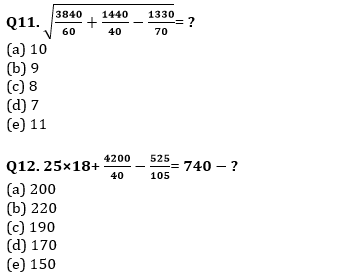
Q13. 3845+4380+2640 – 5965 = (?)²
(a) 75
(b) 60
(c) 80
(d) 70
(e) 72
Q14. 400÷20×35+6666÷33+ ? = 1100
(a) 180
(b) 198
(c) 195
(d) 205
(e) 200
Q15. 28×14.5+1680÷15+445=1000 -?
(a) 27
(b) 37
(c) 47
(d) 50
(e) 40
Solutions
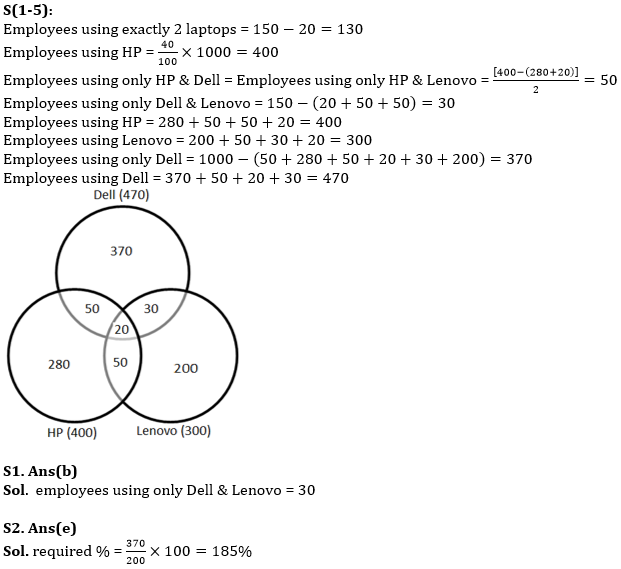
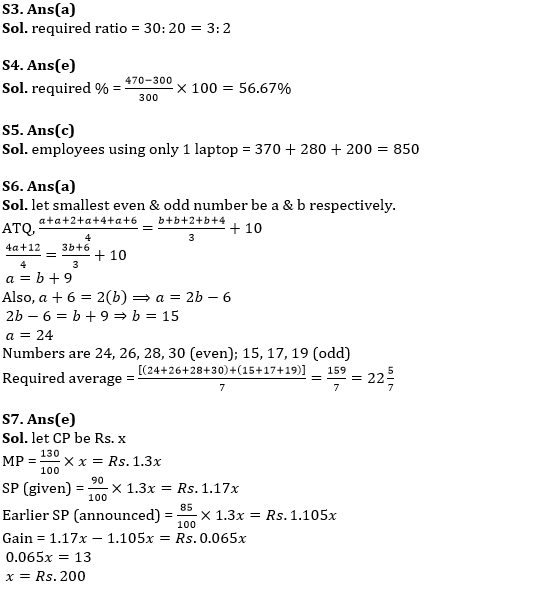

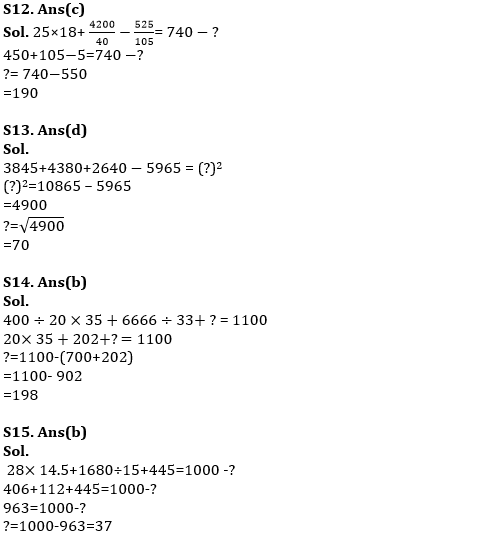
Quantitative Aptitude Books for Preparation
To excel in the bank examination one needs to learn new concepts and practice the questions, for that Books are the best. These books cover the required topics comprehensively including essential mathematical concepts and provide ample practice questions.
| Quantitative Aptitude Books for Preparation | |
| Book | Link |
| Ace Quantitative Aptitude Book For Banking and Insurance | Click Here to Check |
| A Complete Book of Data Interpretation | Click Here to Check |
| Daksh Quant A Comprehensive Book On Quantitative Aptitude | Click Here to Check |
| The Viral Maths | Click Here to Check |





